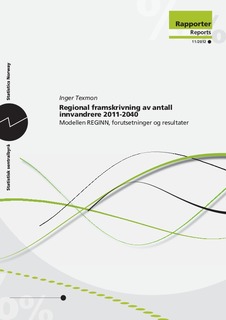| dc.contributor.author | Texmon, Inger | |
| dc.date.accessioned | 2012-03-13T12:21:40Z | |
| dc.date.available | 2012-03-13T12:21:40Z | |
| dc.date.issued | 2012 | |
| dc.identifier.issn | 1892-7513 | |
| dc.identifier.uri | http://hdl.handle.net/11250/181203 | |
| dc.description | Det er første gang en regional innvandrerframskrivning er publisert i Norge.
Tidligere har Statistisk sentralbyrå laget separate innvandrerframskrivninger på
nasjonalt nivå i 2005 og i hvert av årene 2008-2010. I 2011 ble det så utviklet en ny
modell (BEFINN), der beregningene av det framtidige antallet innvandrere er
integrert i framskrivningen av folkemengden. | no_NO |
| dc.description.abstract | Denne rapporten omtaler framskrivninger av antall innvandrere fordelt etter
bostedsregion i Norge. Som i de tidligere innvandrerframskrivningene på nasjonalt
nivå er både innvandrere og norskfødte barn av to innvandrerforeldre med, og disse
to kategoriene er videre delt inn i tre grupper etter landbakgrunn. Det er laget en
egen regional inndeling til formålet, med i alt 31 regioner. Grensene mellom dem
følger i stor grad fylkesgrensene, men de omfatter også enkeltkommuner eller
grupper av kommuner. Spesielt de største byene er skilt ut som egne regioner.
Basert på denne inndelingen ser vi i rapporten hvordan utviklingen i innvandreres
bosettingsmønster har vært gjennom de tiårene vi har bak oss, noe som gir en
bakgrunn for å tolke framskrivningsresultatene. ---- This report presents the first regional projections of the population of immigrants
and their children born in Norway. The immigrants are divided into three groups
based on country background. A newly developed model REGINN is applied for
the projections. The report includes descriptions of the main principles of the
model.
The regional projections are based on a division of the country into 31 regions. One
aim has been to avoid too small regions, and at the same time follow the borders
between administrative regional units, as the 19 Norwegian counties. In some
counties urban municipalities with immigrant populations of a substantial size are
separate regions. The report describes some broad lines of the settlement of immigrants
in Norway during the period 1970-2010, whereas the trends in international
and domestic migration are studied for a shorter period and with focus on the
period 2006-2010. Most of the assumptions on the regional level are based on
observations of this 5-year period prior to the base year 2011.
The assumptions of fertility, mortality and international migration are consistent
with assumptions on the national level in the official national projection published
in June 2011. This means that in each alternative of the new regional projection,
the figures sum up to the national figures which were published half a year ago. For
this reason it is the regional patterns that are emphasized in the descriptions of past
trends. | no_NO |
| dc.description.sponsorship | Prosjektet er støttet av Barne-, likestillings- og inkluderingsdepartementet. | no_NO |
| dc.language.iso | nob | no_NO |
| dc.publisher | Statistisk sentralbyrå | no_NO |
| dc.relation.ispartofseries | Rapporter;2012/11 | |
| dc.subject | Demografi | no_NO |
| dc.subject | Befolkningsframskrivning | no_NO |
| dc.subject | Norge | no_NO |
| dc.subject | Innvandrere | no_NO |
| dc.subject | Geografisk inndeling | no_NO |
| dc.subject | Regional befolkningsframskrivn | no_NO |
| dc.subject | Innvandring | no_NO |
| dc.subject | Kommuner | no_NO |
| dc.subject | Fylker | no_NO |
| dc.subject | Oslo | no_NO |
| dc.title | Regional framskrivning av antall innvandrere 2011-2040. Modellen REGINN, forutsetninger og resultater | no_NO |
| dc.type | Report | no_NO |
| dc.subject.nsi | VDP::Social science: 200::Demography: 300 | no_NO |
| dc.source.pagenumber | 61 s. | no_NO |
